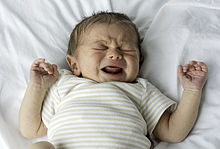User:Mr. Ibrahem/Baby colic
| Colic | |
|---|---|
| Other names | Infantile colic |
 | |
| A crying newborn | |
| Specialty | Pediatrics |
| Symptoms | Crying for more than three hours a day, for more than three days a week, for three weeks[1] |
| Complications | Frustration for the parents, depression following delivery, child abuse[1] |
| Usual onset | Six weeks of age[1] |
| Duration | Typically goes away by six months of age[1] |
| Causes | Unknown[1] |
| Diagnostic method | Based on symptoms after ruling out other possible causes[1] |
| Differential diagnosis | Corneal abrasion, hair tourniquet, hernia, testicular torsion[2] |
| Treatment | Conservative treatment, extra support for the parents[1][3] |
| Prognosis | No long term problems[4] |
| Frequency | ~25% of babies[1] |
Baby colic, also known as infantile colic, is defined as episodes of crying for more than three hours a day, for more than three days a week, for three weeks in an otherwise healthy child.[1] Often crying occurs in the evening.[1] It typically does not result in long-term problems.[4] The crying can result in frustration of the parents, depression following delivery, excess visits to the doctor, and child abuse.[1]
The cause of colic is unknown.[1] Some believe it is due to gastrointestinal discomfort like intestinal cramping.[5] Diagnosis requires ruling out other possible causes.[1] Concerning findings include a fever, poor activity, or a swollen abdomen.[1] Fewer than 5% of infants with excess crying have an underlying organic disease.[1]
Treatment is generally conservative, with little to no role for either medications or alternative therapies.[3] Extra support for the parents may be useful.[1] Tentative evidence supports certain probiotics for the baby and a low-allergen diet by the mother in those who are breastfed.[1] Hydrolyzed formula may be useful in those who are bottlefed.[1]
Colic affects 10–40% of babies.[1] It is most common at six weeks of age and typically goes away by six months of age.[1] It rarely lasts up to one year of age.[6] It occurs at the same rate in boys and in girls.[1] The first detailed medical description of the problem occurred in 1954.[7]
References[edit]
- ^ a b c d e f g h i j k l m n o p q r s t u Johnson, JD; Cocker, K; Chang, E (1 October 2015). "Infantile Colic: Recognition and Treatment". American Family Physician. 92 (7): 577–82. PMID 26447441. Archived from the original on 26 August 2017. Retrieved 22 July 2017.
- ^ "Colic Differential Diagnoses". emedicine.medscape.com. 3 September 2015. Archived from the original on 5 November 2017. Retrieved 1 June 2017.
- ^ a b Biagioli, E; Tarasco, V; Lingua, C; Moja, L; Savino, F (16 September 2016). "Pain-relieving agents for infantile colic". The Cochrane Database of Systematic Reviews. 9: CD009999. doi:10.1002/14651858.CD009999.pub2. PMC 6457752. PMID 27631535.
- ^ a b Grimes JA, Domino FJ, Baldor RA, Golding J, eds. (2014). The 5-minute clinical consult premium (23rd ed.). St. Louis: Wolters Kluwer Health. p. 251. ISBN 9781451192155. Archived from the original on 2015-02-25.
- ^ Shamir, Raanan; St James-Roberts, Ian; Di Lorenzo, Carlo; Burns, Alan J.; Thapar, Nikhil; Indrio, Flavia; Riezzo, Giuseppe; Raimondi, Francesco; Di Mauro, Antonio (2013-12-01). "Infant crying, colic, and gastrointestinal discomfort in early childhood: a review of the evidence and most plausible mechanisms". Journal of Pediatric Gastroenterology and Nutrition. 57 Suppl 1: S1–45. doi:10.1097/MPG.0b013e3182a154ff. ISSN 1536-4801. PMID 24356023.
- ^ Barr, RG (2002). "Changing our understanding of infant colic". Archives of Pediatrics & Adolescent Medicine. 156 (12): 1172–4. doi:10.1001/archpedi.156.12.1172. PMID 12444822.
- ^ Long, Tony (2006). Excessive Crying in Infancy. John Wiley & Sons. p. 5. ISBN 9780470031711. Archived from the original on 2016-10-18.
